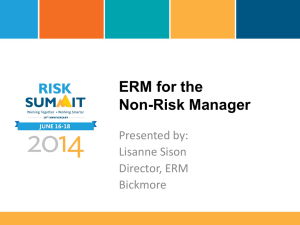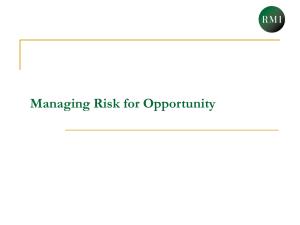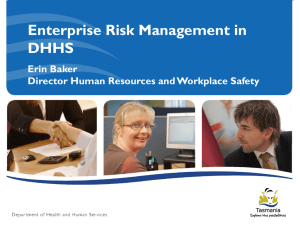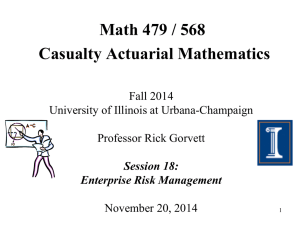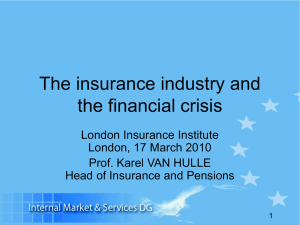S5.1_Miwa_Argentina 2011
advertisement
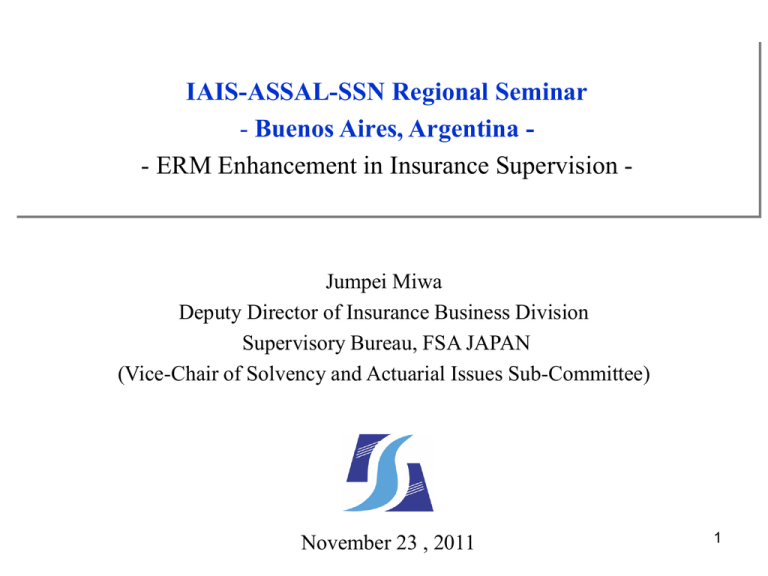
IAIS-ASSAL-SSN Regional Seminar - Buenos Aires, Argentina - ERM Enhancement in Insurance Supervision - Jumpei Miwa Deputy Director of Insurance Business Division Supervisory Bureau, FSA JAPAN (Vice-Chair of Solvency and Actuarial Issues Sub-Committee) November 23 , 2011 1 Table of Contents History of ERM Enhancement Recent Trends of ERM Enhancement Enhancement of risk management in JAPAN 2 History of International Development relating to Risk Managements Environment Events New Products Securitisation 90’s 1988 BCBS Basel I Credit Derivatives 1992 COSO “Internal Control - Integrated Framework” 1996 Basel I -Market Risk Amendment- New Risks -Operational Risk etc- BCCI Daiwa BK NY Bearing 1998~ BCBS initiated works for Basel II - Introduction of risk-sensitive approach and operational risk - 2004 BCBS Basel II COSO-ERM 2008 IAIS Standards and Guidance on ERM 2009 G20 initiatives (FSB developments) New Phenomena - Contagion Risks High Leverage Heavy Use Originate of Rating to Distribution Agency - ABS CDOs etc.- 00’s Systemic Risks Lehman’s Shock AIG Issues -Non-traditional insurance business - 2010~ IAIS initiated works for “ComFrame” for International Active Insurance Groups (IAIGs) 2010 BCBS Basel III 2011 Group-based ICP 3 Banking Sector’s Developments by BCBS - late 1990’s to early 2000’s Motivation to revise 1) Revision from crude measurement in Basel I to more advanced measurement - Basel I is so simple but not fully reflecting credibility in different borrowers 2) Necessity to address new risks (Operational Risk in Pillar 1) - Incidents of Barings Securities (1995) and The Daiwa Bank (1995) 3) Reflection of advances in internal risk management practices or techniques at banks - Proper recognition of risk mitigation techniques (by Credit derivatives) and risk transfer (by Securitization) developed in 90’s June 2004: Basel II (BCBS) Pillar 1 Minimum Capital Requirement Pillar 2 Supervisory Review Process Pillar 3 Market Discipline (Disclosure) However, the global financial turmoil occurred in 2008 before the implementation of Basel II by U.S.. - The U.S. is still under the process for implementation of Basel II – Dec. 2010: Basel III (BCBS) 4 Insurance Sector Developments by IAIS - Guidance Paper on ERM to Next Banking Sector’s Efforts Basel II (’04) Pillar 2 Supervisory Review Process - ICAAP- Industry Developments Solvency II Efforts in EU COSO ERM (’04) Similar framework to 3 Pillar’s system in Basel II IAIS: Guidance Paper on Enterprise Risk Management for Capital Adequacy and Solvency Purpose (2008) - 19 requirements • Governance and an ERM (1- 5) • Own Risk and Solvency Assessment (13- 14) • Risk Management Policy (6- 7) • Economic and Regulatory Capital (15- 16) • Risk Tolerance Statement (8- 10) • Continuity Analysis (17- 18) • Risk responsiveness and feedback loop (11- 12) Group-based ICP (2011) Principle 16 ・Role of Supervision (19) ComFrame (2010-) 5 IAIS Developments – ComFrame • Schedule – Initiate its work from July 2010 – Development Phase for 3 years and Calibration Phase form mid-2013 – Concept Paper publishes in July 2011 July 2011 July 2012 July 2013 Concept Paper 6 IAIS Developments - ComFrame • • Aim & Purpose – Develop methods of operating group-wide supervision of Internationally Active Insurance Groups (IAIGs) – Establish a comprehensive framework for supervisors to address group-wide activities and risks – Set grounds for better supervisory cooperation – Foster global commonalities Framework (Module) – Module1 (Scope of Application) – Module2 (Group Structure and Business) – Module3 (Quantitative and Qualitative Assessment) – Module4 (Supervisory Cooperation and Interaction) – Module5 (Jurisdictional Matters) Solvency-related contents • Element 2 (Priority B) Enterprise Risk Management (ERM) • Element 3 (Priority B) Liabilities/technical provisions and assets/investments • Element 4 (Priority B) Valuation • Element 5 (Priority B) Capital Adequacy 7 Table of Contents History of ERM Enhancement Recent Trends of ERM Enhancement Enhancement of risk management in JAPAN 8 Potential Questions on ERM Risk Tolerance ORSA Risk Appetite XXX Governance - Internal Control - XXX XXX Enterprise Risk Management (ERM) XXX Stress testing Economic Capital Risk Identification - Internal Models - ERM Potential Questions: • Too much technical terms and too abstract concepts • How to be effective and how to establish the interplay - among governance, risk quantification and business strategy – • Which framework should be prioritized? 9 Recent Trends on ERM after global turmoil - Highlight of the concept of Risk Appetite- Mid-2000’s The term and concepts of “ERM” and “Internal Control” had become popular in the market and industry’s practice. (thanks to COSO ERM etc.) 2008 Global financial turmoil occurred (before ERM practice had not been sufficiently established) Based on the lesson learned in turmoil, ERM practices have been more articulated. – The “Risk Appetite Framework” has been more highlighted especially in the companies who sustained damage from turmoil The Senior Supervisory Group (SSG*) (in the banking sector) played significant role in evolving concepts of the Risk Appetite. – 3 working papers published The Industry responded to the SSG – IIF (The Institute of International Finance) published the working paper - Implementation Robust Risk Appetite Frameworks to Strengthen Financial Institutions (June 2011) * The Senior Supervisors Group (SSG) is a forum for senior representatives of supervisory authorities to engage in dialogue on risk management practices, governance, and other issues concerning complex, globally-active financial institutions. The group is comprised of senior executives from the bank supervisory authorities of those institutions’ home jurisdictions. The SSG leverages the network of relationships in the Group to share information on supervisory approaches and also engages with the financial services industry to better understand new challenges and emerging risks that systemically important institutions face. (From the “Mission Statement” by FSB) 10 Recent Trends on ERM after global turmoil - SSG Developments of Risk Appetite- “Observations on Risk Management Practices during the Recent Market Turbulence” (Senior Supervisors Group (SSG) March 6, 2008) – The importance of appropriate balance between Risk Appetite and risk controls is identified “Risk Management Lessons From Global Banking Crisis of 2008” (Senior Supervisors Group*(SSG) Oct 22, 2009) – The necessity of “Articulating Risk Appetite” is clarified in “Areas for Continued Improvement”–so-called “Ten Lessons” by SSG- . – Self-Assessment Template is attached “Observations on Developments in Risk Appetite Frameworks and IT infrastructure” (Senior Supervisors Group*(SSG) Dec 23, 2010) – Implementation of a Risk Appetite Framework – Identification of progress in conceptualizing, articulating and implementing a risk appetite framework in many firms 11 “Risk Management Lessons From Global Banking Crisis of 2008” (Oct. 2009) – The “Areas for Continued Improvement”–so-called “The Ten Lessons” by SSG- . 1. Board Direction and Senior Management Oversight • Firms are generally undertaking adjustments to increase board and executive engagement and to strengthen the resources, stature, and authority of risk management; however, it is not yet clear whether these changes have contributed to stronger governance. 2. Articulating Risk Appetite • Supervisors see insufficient evidence of board involvement in setting and monitoring adherence to firms’ risk appetite. • Risk appetite statements are generally not sufficiently robust; such statements rarely reflect a suitably wide range of measures and lack actionable elements that clearly articulate firms’ intended responses to losses of capital and breaches in limits. 3. Compensation Practices • Most firms recognize that past compensation practices were driven by the need to attract and retain staff and were often not integrated within firms’ control environments. • Firms note the need to align better compensation with the risk appetite and are considering initial steps in this direction. • Supervisors are concerned about the durability of proposed changes. 4. Information Technology Infrastructure • The importance of a resilient IT environment with sufficient processing capacity in periods of stress is becoming increasingly evident. • Firms are constrained in their ability to effectively aggregate and monitor exposures across counterparties, businesses, risk strands, and other dimensions because of ineffective information technology and supporting infrastructure. 5. Risk Aggregation and Concentration Identification • Self-assessment responses suggest that identification of risk concentrations is an area of weakness; firms are looking to automate identification of concentrations by counterparty, product, geography, and other classes. 6. Stress Testing • Firms report enhancements to and increased use of stress testing to convey risk to senior management and boards, although significant gaps remain in their ability to conduct firmwide tests; credibility of extreme scenarios, despite recent events, remains an issue for some firms. 7. Counterparty Risk Management • Flexibility in some firms’ CCR management systems proved particularly valuable; in co ntrast, the inability of other firms’ CCR systems to identify directional risk drivers limited these institutions’ responsiveness to sharp changes in exposures. 8. Valuation Practices and Loss Recognition • The loss of confidence among creditors, counterparties and clients in firms’ valuation practices for certain assets during the crisis contributed directly to the withdrawal of funding and other liquidity drains on firms in varying forms. • Many firms are reviewing the oversight of their valuation function and working to increase the rigor of processes associated with, for example, enforcing uniform pricing across the firm, valuing models, and escalating valuation disputes; nonetheless substantial work remains for firms to adhere to industry standards for valuation practices. 9. Operations and Market Infrastructure • Firms are making substantial progress standardizing practices, reducing backlogs of unconfirmed OTC derivatives positions, and improving collateral management techniques. • Notwithstanding the significant efforts by firms to mitigate risk, work remains to improve key personnel’s detailed knowledge of financial market utilities and communication with settlement infrastructure providers. 10. Liquidity Risk Management • As a result of lessons from the crisis, firms are making meaningful progress improving funding and liquidity risk management practices, but supervisors and some firms acknowledge that substantial work remains to align fully with industry standards. 12 Recent Trends on ERM after global turmoil - What is Risk appetite Framework? The Risk Appetite Framework contains more strategic and forward-looking features in management- (c.f.) ORSA (A Risk Tolerance is similar but mainly represents the limit of risk-taking) A risk communication tool - commonality in RAF and ORSA An Example: “Risk Appetite Framework” c.f. ORSA illustration Governance and an Enterprise Risk Management Framework Feature 1 Financial Target - Profit etc.- Business Strategy Risk Management Policy Risk Tolerance Statement Feedback Loop Risk Appetite Framework Own Risk and Solvency Assessment (ORSA) Feedback Loop Risk Management Risk Quantification Continuity Analysis Economic and Regulatory Capital Role of supervision Feature 8 IAIS: Guidance Paper on Enterprise Risk Management for Capital Adequacy and Solvency Purpose (2008) 13 Table of Contents History of ERM Enhancement Recent Trends of ERM Enhancement Enhancement of risk management in JAPAN 14 For better ERM framework - A case of insurance industry in Japan Fundamental recognition for better ERM Practical enhancement for more sophisticated ERM approach is under progress. Fundamental issues for better ERM - “Know Your Size” (Pursuing most suitable risk management according to company size) - “Know Your Own Risk Profile” (Proper recognition for changes of risk profile over time) Taking into account specific environment in Japan for better ERM Characteristics of hyper long-term liability in most of Japanese life insurance companies A lack of suitable market assets (bonds etc.) consistent with long-term liability Consider for better solutions on the comprehensive ALM strategy living with the hyper longterm liability Large natural disaster risks (earthquakes etc.) potentially possessed by Japanese non-life insurance companies Specific risk profile and data constraints - difficulties both in model use and model validation Consider for better capture of the risk with specific profile 15 Regulatory Developments in Insurance Supervision - after the global financial turmoil Following the financial turmoil in 2008, JFSA has set out the regulatory package in insurance supervision. Newly Incorporated in “Supervisory Guideline” and “Inspection Manual”. • Guideline for Encouragement of disclosure on securitised products (April 2009) • Guideline for the Enhancement of risk management (June 2009) Integrated Risk Management (Enterprise Risk Management) Stress Testing Risk Management for complex instruments • Manual for verification of Integrated Risk Management (June 2011) Revision of “Insurance Business Act” etc. • Revision of Solvency Regime* in JAPAN Group-based solvency regulation (May 2010) Strengthening of Risk factors recalibrated by reflecting the recent market data (April 2010) 16 * The risk-based solvency regime has been applied in Japan since late 1990’s. Supervisory Policies for Insurance Sector - Program Year 2011JFSA annually published its policy for supervision. “Three Emphasized Areas” are set up in the policy placing emphasis on the enhancement of sophistication in risk management. I. Promoting the “Sophistication of Risk Management” II. Improving “Customer Protection” and “Convenience for Users” III. Taking a “Supervisory Response Corresponding to the Characteristics of Insurance Companies” Promoting the “Sophistication of Risk Management” [1] Supervisory Review on risk management systems - ERM interviews etc. [2] Supervisory Review on group-wide governance and risk management Review of “Solvency Assessment” [1] Smooth introduction of renewed solvency calculation (stricter risk factor) [2] Addressing the practical issues on solvency assessments on a basis of economic value with expert organizations (Institutes of Actuaries in Japan etc.) 17 Ongoing developments for more economic-based approach - Field Test on economic valuation - Current System Policy holders' protection Prolonged low interest rate environment Potential Issues Mismatch between current liability and the economically valued assets Potential impediment of effective ALM Insurance liability calculation on a conservative basis • Use of conservative initial assumed interest rate etc. • Additional policy reserves considered through ex-post verification against downside risks – decrease of interest rate or worse of mortality rate Careful impact assessment to more economically valued liability – conduct the “Field Test” (2010) 18 Ongoing Developments for more economic-based approach - Field Test on economic valuation • • Purpose of Field Test – To examine the impact and feasibility for economic-based liability – To identify the technical and practical issues Outline – All insurance companies (47 life insurers and 50 non-life insurers) participated – May 2011 Announcement of the results Findings • • Valuation of insurance liabilities – Most insurers express the importance of the economic valuation of liabilities - which leads to ALM enhancements and further sophistication of risk management – However, some life insurers insisted strongly that careful consideration should be given to those insurers with long-term insurance liabilities as there is no corresponding long-term debt market to achieve effective ALM. Feasibility Issues – Calculation efforts in the estimation of future cashflow were often expressed as a heavy burden for many insurers as it requires every single policy contract to be recalculated for the entire contract period. – Opinion is divided between using sovereign bonds or swap rates in the definition of risk-19 free rates. Ongoing Developments for more economic-based approach - Future Directions • Given the results of the Field Test – Practical issues and challenges were identified especially in insurance liabilities and the use of internal models Current work Continuous work • Further examination in cooperation with relevant organizations, such as the Institute of Actuaries of Japan and the Non-Life Insurance Rating Organization of Japan Contribution for IAIS development Exchange of views on the practical challenges in other jurisdictions - Solvency 2 with European partners (Equivalence process etc.) Providing the roadmap through continuous dialogue with industry Development of more risk-sensitive regulatory framework suited to the characteristics of the insurance market in Japan (taking into consideration hyper long term liability or natural disaster risk etc.) consistent with internationally accepted principles 20 Thank You NOTE: The views expressed in the paper are those of the author and are not necessarily reflective of official views at Financial Services Agency. 21 APPENDIX 22 About Financial Services Agency, Japan Policy Planning Bureau* (Staff: around 330) Supervisory Bureau* Regional Offices (11)* Inspection Bureau* (Staff: around 270) (Staff: around 1,460) (Staff: around 430) Off-site Supervision Off-site Supervision On-site Inspection On-site Inspection * The number of staff (end-March, 2009) for each bureaus/offices include those involved in work related to Non-bank supervision. 23 Comparative Study: Financial Supervision of Major Countries G 2 0 24 Basel II: The Three Pillars Pillar 1 – Minimum Capital Requirements ≥ 8% Updated Credit Risk New Op. Risk Market Risk more accurate in risk measurement The Standardised Approach Foundation IRB Advanced IRB Pillar 2 New – Supervisory Review Process Capital Risk New Credit Risk Mitigation / Securitisation Basic Indicator Approach (BIA) • Capital adequacy assessment process (CAAP) at banks • Supervisory review of CAAP, and early intervention (if necessary) • Risks not covered under Pillar 1: The Standardised Approach (TSA) Advanced Measurement Approach (AMA) The Standardised Approach - Interest rate risk - Concentration risk - Liquidity risk, etc. Pillar 3 – Market Discipline • Developed a set of disclosure requirements to encourage market discipline. • Key information: - Scope of application Capital Capital adequacy Risk exposures Risk assmn’t process. Internal Models Approach 25 EU Solvency 2 • Features – Risk-based and market consistent measurement on asset and liability – Group supervision – Use of Internal Model • Extending and improving the existing quantitative supervision • Proportionality (Partial use of internal model) • Three Pillars System Quantitative Capital Requirement (SCR, MCR) • Market Consistent Valuation • Confidence Level: 99.5% - Internal Model - Standard Formula Qualitative Supervisory Review Process • Governance • ORSA - Self assessment on risks and solvency Reporting Supervisory Reporting Public Disclosure • Consistency between IAIS and IASB • Burden-reduced but sufficient disclosure 26 Enhancement of Integrated Risk Management “Supervisory Guideline for Insurance Companies” (June, 2009) Key Viewpoints Policy for Integrated Risk Management Governance Contents • Setting a policy for integrated risk management by the board of directors strategic goals of the entire insurance company a basic concept for the establishment of Risk Limit and Risk Tolerance • Specifying the responsibility dependant on characteristics, scale and complexity of business • Developing an environment to ensure the reporting to the board of directors in a timely and appropriate manner • Ensuring the checks-and-balances function • Reviewing and Updating the framework according to changes in the surrounding circumstances. 27 Enhancement of Integrated Risk Management “Supervisory Guideline for Insurance Companies” (June, 2009) Key Viewpoints Contents Making use of information • Use of obtained and available information for the execution of business and the development of management systems If not available, best technique or estimates should be adapted not relying on subjective judgments • Recognition of important risks from among all risks, (including insurance underwriting risk, credit risk, market risk, liquidity risk, operational risk and information system risk) Proper Recognition of Important Risks insurance companies that are subject to quantitative integrated risk management specify in writing. insurance companies that are not subject to quantitative integrated risk management take into consideration the framework based on qualitative assessment. 28 Enhancement of Integrated Risk Management “Supervisory Guideline for Insurance Companies” (June,2009) Key Viewpoints Contents • Use a “common measure” such as economic value etc. • Ensure the objectivity and appropriateness Quantification of Risks the proper confidence interval and the holding period when the VaR approach is used • Conduct analysis of future capital adequacy in light of the medium- and long-term business strategies and the business environment • Improve the accuracy of the quantification on continuous basis (Validation) 29



